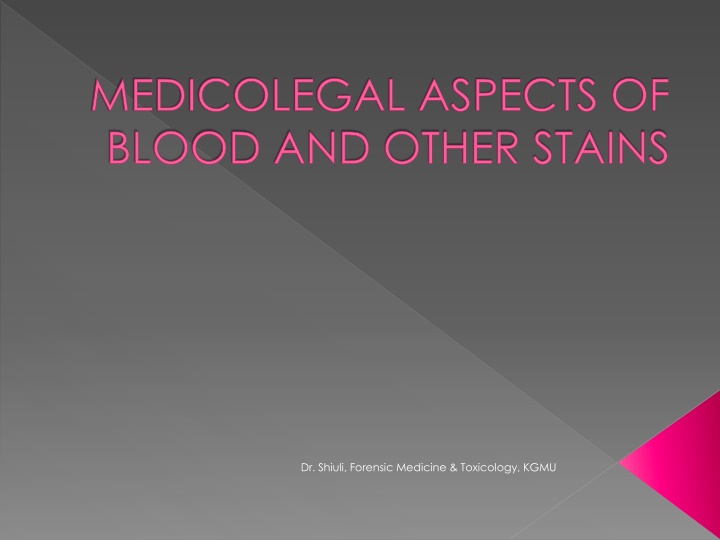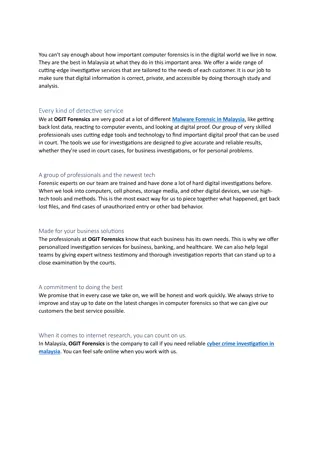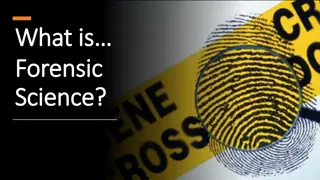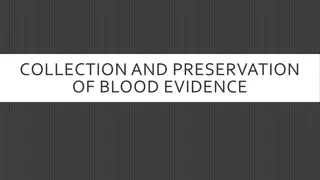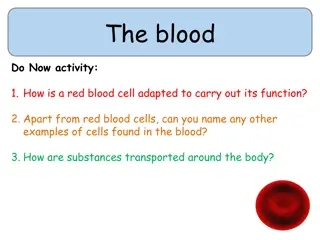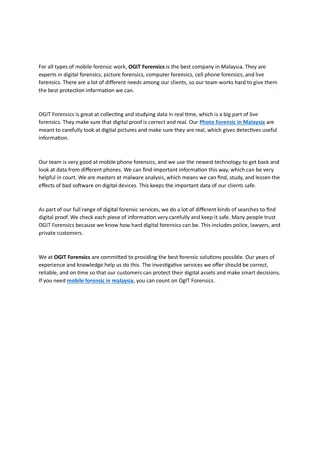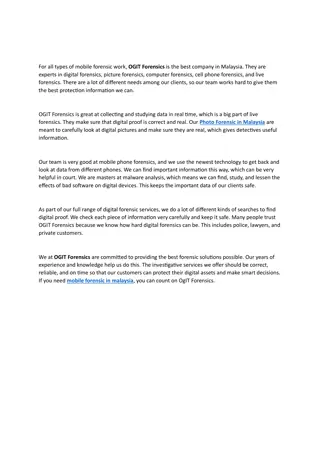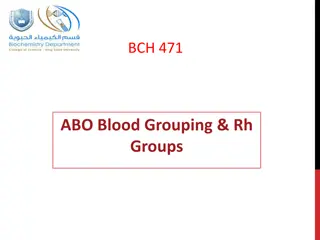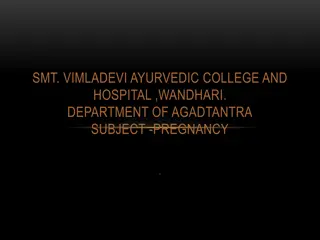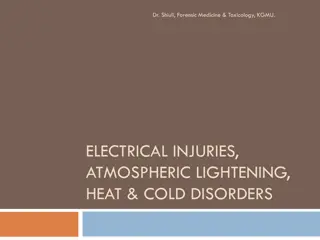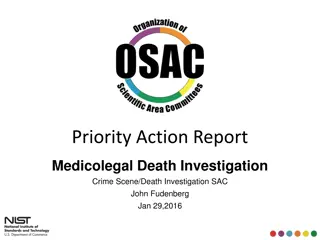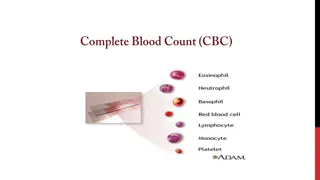Medicolegal Aspects of Blood Stains - Forensic Insights by Dr. Shiuli
Explore the forensic significance of different stains like blood, seminal fluid, and saliva, along with their implications in establishing links between offenses and offenders. Learn about the examination methods, identification of human blood stains, and distinguishing factors from other substances. Dr. Shiuli from KGMU provides valuable insights into the medicolegal aspects of stains in forensic medicine and toxicology.
Download Presentation

Please find below an Image/Link to download the presentation.
The content on the website is provided AS IS for your information and personal use only. It may not be sold, licensed, or shared on other websites without obtaining consent from the author.If you encounter any issues during the download, it is possible that the publisher has removed the file from their server.
You are allowed to download the files provided on this website for personal or commercial use, subject to the condition that they are used lawfully. All files are the property of their respective owners.
The content on the website is provided AS IS for your information and personal use only. It may not be sold, licensed, or shared on other websites without obtaining consent from the author.
E N D
Presentation Transcript
MEDICOLEGAL ASPECTS OF BLOOD AND OTHER STAINS Dr. Shiuli, Forensic Medicine & Toxicology, KGMU
Different stains having Medicolegal importance Blood Seminal fluid Vaginal discharge Saliva Faecal stain Urine Dr. Shiuli, Forensic Medicine & Toxicology, KGMU
Blood stains -Main cellular content RBC Haemoglobin which possess peroxidase activity -Haemoglobin and other proteins of blood has antigenic properties antibodies when injected into animals produces Dr. Shiuli, Forensic Medicine & Toxicology, KGMU
Medicolegal importance May establish a link between offence, offended and offender May establish link between offence and offensive agent Fictitious charges by presenting an animal stain as human In poisoning, poison chemically detected Time since death may be estimated by chemical and enzymatic study Dr. Shiuli, Forensic Medicine & Toxicology, KGMU
Examination Whether the stain is actually a blood stain Physical Chemical Microscopic Spectroscopic Micro chemical Dr. Shiuli, Forensic Medicine & Toxicology, KGMU
Whether the blood stain is of human or other than human Precipitin test If human, which blood group Sex, source Indication as to cause of death Whether belong to victim or accused Whether bleeding antemortem or postmortem Any disease process Dr. Shiuli, Forensic Medicine & Toxicology, KGMU
Substances resembling blood stain Vegetable stains - ammonia greenish yellow color - Bleached by chlorine water - M/E vegetable cells and fibers Rust stains - Does not fall off in scale on being heated - Positive reaction for iron - Dissolved in dil. Hcl Dr. Shiuli, Forensic Medicine & Toxicology, KGMU
Mineral stains Synthetic dye stains - Nitric acid yellow strong alkali original color Other stains Dr. Shiuli, Forensic Medicine & Toxicology, KGMU
Chemical examination Highly sensitive Positive reaction even with faint traces of blood Principal factor peroxidase activity liberating nascent oxygen which leads to colour change Dr. Shiuli, Forensic Medicine & Toxicology, KGMU
1. BENZIDINE TEST stain extract in hydogen peroxide glacial acetic acid benzidine 10 vol Blue colour Dr. Shiuli, Forensic Medicine & Toxicology, KGMU
2. KASTLE MAYER TEST - Phenolphthalein in alkaline medium Pink colour 3. ORTHOTOLIDINE TEST (4% orthotolidine in ethyl alcohol)+ glacial acetic acid + H2O2 - Green colour 4. LEUCHOMALACHITE GREEN TEST Bluish green colour 5. LUMINAL TEST - - - Dr. Shiuli, Forensic Medicine & Toxicology, KGMU
Confirmatory tests for blood Dr. Shiuli, Forensic Medicine & Toxicology, KGMU
Microscopic test RBC s- confirmatory Species Sex Disease Dr. Shiuli, Forensic Medicine & Toxicology, KGMU
Microchemical test HAEMIN CRYSTAL TEST/ TEICHMAN S TEST - Sod. Chloride + strain extract + glacial acetic acid - Yellowish brown rhombic crystals of haemin HAEMOCHROMOGEN CRYSTAL/ TAKAYAMA TEST - takayama reagent + stain extract - Salmon pink hemochromogen crystals Dr. Shiuli, Forensic Medicine & Toxicology, KGMU
Spectroscopic examination Detects blood where RBC structure is lost and hemoglobin has undergone chemical composition Dr. Shiuli, Forensic Medicine & Toxicology, KGMU
Species specification test PRECIPITIN TEST - When human serum is injected in an experimental animal, antibodies develop. - When any human serum is brought in contact with this animal serum, the antibodies and protein will react and a visible precipitate will develop Dr. Shiuli, Forensic Medicine & Toxicology, KGMU
Identifying sex from blood stain - Barr bodies in > 3% of polymorphs - Y chromosome is fluorescent to quinacrine Dr. Shiuli, Forensic Medicine & Toxicology, KGMU
Individuality by blood stain Blood grouping red cell antigen White cell antigen Se protein polymorphism Red cell enzyme polymorphism Dr. Shiuli, Forensic Medicine & Toxicology, KGMU
Red cell antigen ABO system Rh system MNSs group system Lutheran Duffy Lewis Kidd Dr. Shiuli, Forensic Medicine & Toxicology, KGMU
Group specific substances Agglutinogens in water soluble form Secrete ABO antigens into body fluids and secretions secretors Non secretors Agglutinogens in lipoidal form Dr. Shiuli, Forensic Medicine & Toxicology, KGMU
White cell antigen Human Leucocyte Antigen (HLA)- the MHC in humans Present on Chromosome 6 and encode cell surface antigen presenting proteins 4 types HLA-A, HLA-B, HLA-C, HLA-D Dr. Shiuli, Forensic Medicine & Toxicology, KGMU
Serum protein polymorphism Occurrence in the same population of two or more alleles at one locus, each with appreciable frequency, where the minimum frequency is taken as 1% Se. proteins subject to genetic variation are Se. haptoglobins Se lipoproteins Abnormal haemoglobins Dr. Shiuli, Forensic Medicine & Toxicology, KGMU
Red cell enzyme polymorphism > 250 proteins & enzymes found in red cell Established value in paternity testing Phopho glucomutase Adenylate kinase Dr. Shiuli, Forensic Medicine & Toxicology, KGMU
